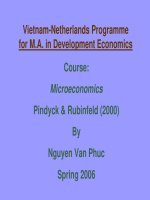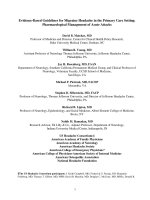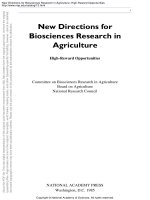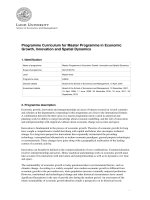Managing distribution channel for beer products in habeco trading one member company limited
Bạn đang xem bản rút gọn của tài liệu. Xem và tải ngay bản đầy đủ của tài liệu tại đây (1.99 MB, 105 trang )
ĐẠI HỌC QUỐC GIA HÀ NỘI
KHOA QUẢN TRỊ VÀ KINH DOANH
---------------------
NGUYỄN MẠNH HÙNG
MANAGING DISTRIBUTION CHANNEL FOR BEER PRODUCTS IN
HABECO TRADING ONE MEMBER COMPANY LIMITED
ĐẨY MẠNH QUẢN LÝ KÊNH PHÂN PHỐI CÁC SẢN PHẨM BIA HÀ
NỘI TẠI CÔNG TY TNHH MTV THƯƠNG MẠI HABECO
LUẬN VĂN THẠC SĨ QUẢN TRỊ KINH DOANH
HÀ NỘI - 2018
ĐẠI HỌC QUỐC GIA HÀ NỘI
KHOA QUẢN TRỊ VÀ KINH DOANH
---------------------
NGUYỄN MẠNH HÙNG
MANAGING DISTRIBUTION CHANNEL FOR BEER PRODUCTS IN
HABECO TRADING ONE MEMBER COMPANY LIMITED
ĐẨY MẠNH QUẢN LÝ KÊNH PHÂN PHỐI CÁC SẢN PHẨM BIA HÀ
NỘI TẠI CÔNG TY TNHH MTV THƯƠNG MẠI HABECO
Chuyên ngành: Quản trị kinh doanh
Mã số: 60 34 01 02
LUẬN VĂN THẠC SĨ QUẢN TRỊ KINH DOANH
NGƯỜI HƯỚNG DẪN KHOA HỌC: PGS.TS. HOÀNG ĐÌNH PHI
Hà Nội - 2018
DECLARATION
I declare that the research outcome in this thesis is the result of my
independent work during study and research period and it is not yet published in
other’s research and article.
The other’s research result and documentation (extraction, table, figure,
formula, and other document) used in the thesis are cited properly and the permission
(if required) is given.
I am responsible in front of the Thesis Assessment Committee, Hanoi School
of Business and Management, and the laws for above-mentioned declaration.
ACKNOWLEDGEMENT
“First of all, I would like to send my faithful thanks to Hanoi School of
Business, Vietnam National University (HSB, VNU) with all the members, lecturers
and assistants for the whole knowledge, experience that has been taught and
transferred through comprehensive lectures, discussions and exams in the passing time
of MBA 10 course.”
“Secondly, I would also want to express my sincere appreciation to my
supervisor, Assoc. Prof. Dr. Hoang Dinh Phi. His wide knowledge and logical thought
of business management in general, especially of marketing field has brought great
values to me. Based on his own experience, he had instructed and encouraged me so
much to help me complete this MBA thesis.”
“Thirdly, one of the most important factors which supports me to finish this thesis is
the willing help of many people working at Habeco Trading One Member Company
Limited, especially the leaders, who are very busy at business but still be passionate in
answering my interviews. Absolutely, without their opinions and information, I could never
be able to complete this thesis in a practical and proper manner.”
“Finally, I would like to save my special thanks to my family, without their
encouragement and support, it would be extremely difficult for me to be totally focus on
completing my thesis which is one of my biggest targets in this recent time.”
TABLE OF CONTENTS
ABBREVIATIONS .........................................................................................................i
LIST OF TABLES ....................................................................................................... iii
LIST OF FIGURES ......................................................................................................iv
EXECUTIVE SUMMARY ........................................................................................... 1
CHAPTER 1: INTRODUCTION ................................................................................ 3
1.1. Rationale ................................................................................................................. 3
1.2. Research objectives ................................................................................................ 5
1.3. Research object ....................................................................................................... 5
1.4. Research scope ....................................................................................................... 6
1.5. Research methodology ........................................................................................... 6
1.5.1. Research process ............................................................................................... 6
1.5.2. Data collection .................................................................................................. 6
1.5.3. Data analysis ..................................................................................................... 8
1.6. Research structure .................................................................................................. 8
CHAPTER
2:
THEORETICAL
BACKGROUND
ON
DISTRIBUTION
CHANNEL MANAGEMENT FOR BEER INDUSTRY......................................... 10
2.1. Introduction of beer industry ................................................................................ 10
2.1.1. Beer industry in the world ............................................................................... 10
2.1.2. Beer industry in Vietnam ................................................................................ 13
2.2. Overview of distribution channel ......................................................................... 14
2.2.1. Definition of distribution channel ................................................................... 14
2.2.2. Role of distribution intermediaries.................................................................. 15
2.2.3. Functions of distribution channel .................................................................... 15
2.2.4. Kinds of distribution channel .......................................................................... 16
2.3. Distribution channel management ........................................................................ 17
2.3.1. Selecting channel member .............................................................................. 17
2.3.2. Controlling conflict between channel members.............................................. 18
2.3.3. Motivating channel members .......................................................................... 19
2.3.4. Evaluating distribution channel....................................................................... 20
2.4. Factors affecting distribution channel .................................................................. 21
2.4.1. Market considerations ...................................................................................... 21
2.4.2. Product considerations ..................................................................................... 22
2.4.3. Middlemen considerations ............................................................................... 23
CHAPTER 3: LITERATURE REVIEW .................................................................. 24
3.1. Previous studies on distribution channel management ........................................ 24
3.2. Distribution channel management model applied for Habeco ............................. 27
CHAPTER 3: CURRENT SITUATION OF DISTRIBUTION CHANNEL
MANAGEMENT FOR BEER PRODUCTS OF HABECO TRADING ONE
MEMBER COMPANY LIMITED ............................................................................ 32
4.1. Overview of Habeco Trading One Member Company Limited .......................... 32
4.1.1. History of development and establishment ..................................................... 32
4.1.2. Organizational structure .................................................................................. 37
4.1.3. Human resources ............................................................................................. 38
4.1.4. Current situation of distribution channel system of Habeco ........................... 39
4.2. Dimensions and attributions to manage distribution channel for beer products in
Habeco Trading One Member Company Limited....................................................... 43
4.3. Sample size description ........................................................................................ 44
4.3.1. Gender ............................................................................................................. 44
4.3.2. Age .................................................................................................................. 45
4.3.3. Obtained degree .............................................................................................. 46
4.3.4. Working seniority............................................................................................ 47
4.4. Actual situation of distribution channel for beer products in Habeco Trading One
Member Company Limited ......................................................................................... 47
4.4.1. Selecting members for distribution channel.................................................... 47
4.4.2. Training members for distribution channel ..................................................... 53
4.4.3. Motivating members for distribution channel ................................................. 57
4.4.4. Evaluating distribution channel....................................................................... 62
4.5. Assessment of distribution channel management at Habeco Trading One
Member Co., Ltd ......................................................................................................... 66
4.5.1. Achievements .................................................................................................. 66
4.5.2. Shortcomings ................................................................................................... 66
4.5.3. Causes of shortcomings................................................................................... 68
CHAPTER 5: SOLUTIONS TO STRENGTHEN DISTRIBUTION CHANNEL
MANAGEMENT AT HABECO TRADING ONE MEMBER CO., LTD ............. 72
5.1. Developing orientation of distribution channel management at Habeco Trading
One Member Co., Ltd.................................................................................................. 72
5.1.1. General developing orientation of Habeco Trading One Member Co., Ltd ... 72
5.1.2. Developing orientation of distribution channel management at Habeco
Trading One Member Co., Ltd .................................................................................. 73
5.2. Solutions to strengthen the distribution channel management at Habeco Trading
One Member Co., Ltd.................................................................................................. 73
5.2.1. Improve criteria for selecting channel members ............................................. 73
5.2.2. Improve training courses for channel members .............................................. 74
5.2.3. Improve motivation policy for channel member............................................. 75
5.2.4. Improve evaluation method for channel members .......................................... 76
5.2.5. Improve cooperation with channel members .................................................. 78
5.3. Recommendations ................................................................................................ 79
5.3.1. Recommendation to the State management agencies ..................................... 79
5.3.2. Recommendation to the intermediaries ........................................................... 81
CONCLUSION ............................................................................................................ 84
LIST OF REFERENCES ............................................................................................ 85
APPENDIX 1................................................................................................................ 87
APPENDIX 2................................................................................................................ 88
APPENDIX 3................................................................................................................ 92
ABBREVIATIONS
4P
: Product, Price, Place, Promotion
ABI
: Anheuser-Busch InBev
Assoc. Pro. : Associate Doctor
Bancassur
ance
: Bank + Insurance
BL
: Billion
BOD
: Board of Directors
BVGI
: Bao Viet Insurance Corporation
Co., Ltd
: Company Limited
DC
: Distribution Channel
Dr.
: Doctor
e.g.
: for example
et. al.
: and others
etc.
: et cetera
FMCG
: Fast Moving Consumer Goods
Habeco
: Habeco Trading One Member Company Limited
HRM Dept. : Human Resources Management Department
HSB
: Hanoi School of Business
i.e.
: mean
IT
: Information Technology
KPI
: Key Performance Indicator
MBA
: Master in Business Administration
No.
: Number
PR
: Public Relations
Sabeco
: Saigon Alcohol Beer & Beverages Corp
TPP
: Trans Pacific Partnership Agreement
i
TV
: Television
UK
: United Kingdom
US
: United States
USA
: United States of America
VBL
: Vietnam Brewery Limited
VNU
: Vietnam National University
ii
LIST OF TABLES
Table 4.1: Habeco Trading One Member Co., Ltd’s staff qualification in 2017 ...... 39
Table 4.2: Dimensions and attributions to manage distribution channel for beer
products in Habeco Trading One Member Company Limited ................................. 43
Table 4.3: Criteria for evaluating distribution channels of Habeco Trading One
Member Co., Ltd ....................................................................................................... 50
Table 4.4: Actual situation of selecting member for DC at Habeco Trading One
Member Co., Ltd ....................................................................................................... 51
Table 4.5: Actual situation of training member for DC at Habeco Trading One
Member Co., Ltd ....................................................................................................... 55
Table 4.6: Actual situation of motivating member for DC at Habeco Trading One
Member Co., Ltd ....................................................................................................... 59
Table 4.7: Actual situation of evaluating DC at Habeco Trading One Member Co.,
Ltd ............................................................................................................................. 63
iii
LIST OF FIGURES
Figure 1.1: Research process....................................................................................... 6
Figure 2.1: Total beer volumes from the top 30 beer consuming countries ............. 11
Figure 2.2: Volumes and shares of global countries in beer market ......................... 12
Figure 2.3: Consumer distribution channel ............................................................... 16
Figure 3.1: Distribution channel management model applied for Habeco ............... 28
Figure 4.1: Organizational chart of Habeco Trading One Member Co., Ltd............ 37
Figure 4.2: Organizational chart of each branch of Habeco Trading One Member
Co., Ltd ...................................................................................................................... 38
Figure 4.3: Distribution channel system of Habeco Trading One Member Co., Ltd 40
Figure 4.4: Number of distributors level 1 in 2016................................................... 41
Figure 4.5: Average monthly income of distributors level 1 in 2016 ....................... 41
Figure 4.6: Sample’s gender ..................................................................................... 45
Figure 4.7: Sample’s age ........................................................................................... 45
Figure 4.8: Sample’s qualification ............................................................................ 46
Figure 4.9: Sample’s seniority .................................................................................. 47
iv
EXECUTIVE SUMMARY
“Being considered as the bridge connecting producer/supplier with the final
user or customer, distribution channel is one of the most important factors to make
the success of any enterprise. Actually, an effective management of the distribution
system is the key management element which helps a company to achieve the
competitive advantages fighting against other rivals.”
“Habeco Trading One Member Co., Ltd, established in 2009 after being
separated from Hanoi Beer Alcohol and Beverage Joint Stock Corporation,
hasthereforefull advantage ofbothhuman and resourcestopromote the development
ofthis distribution channel. Thanks to distribution channel is considered as a
strategic point to expand the total sales premium revenue in a long and sustainable
period, the company has established the Marketing and Sales Division to focus on
managing this particular channel since 2010.”
“Before the attractiveness of the Vietnamese beer market, many domestic
and foreign beer companies have been stepping up their investment and competition
to occupy Habeco's market share. In addition, in the trend of modernization,
information technology becomes more and more important and indispensable in the
process of managing and operating the production and business activities of
enterprises. Some major brands in the beer sector have applied very well technology
in sales system management, business efficiency improvement and have boom such
as Saigon Beer, Sapporo, Huda, etc. For those reasons, the researcher himself chose
the
subject
“MANAGING
DISTRIBUTION
CHANNEL
FOR
BEER
PRODUCTS IN HABECO TRADING ONE MEMBER COMPANY LIMITED”
to study and put into practical application at Habeco to improve distribution
activities for beer products at Habeco and improve its competitiveness in the
market.”
“By applying the theoretical framework of “Marketing management”
combined with the actual in-depth interviews with managers (02), distributors (02),
retailers (02) of Habeco, and survey for employees working at the Marketing and
1
Sales Division of Habeco, and employees at 11 branches of the company (104), the
researcher has noted and would perform the following findings.”
“Some achievements include Habeco selects its DC members based on their
reputation, financial strengths and product lines, Habeco usually holds training
courses to improve product knowledge, sales skills and negotiation skills, Habeco
uses some approaches to learn about its DC members’ needs and problems, and
usually gives some monetary rewards and recognition to its DC members with
outstanding and excellent results, etc. Some shortcomings include Habeco does not
take into account the promotion and advertising programs that intermediaries can
give to its beer products, Habeco encounters some problems in holding
communication skills training courses. Moreover, for some specialized training
courses, DC members have to pay some tuition fee, which causes their
dissatisfaction, etc.”
“Finally, looking at the discovered points, the researcher would like to
recommend some solutions to improve the distribution channel management at
Habeco Trading One Member Co., Ltd such as: focus on reviewing and improving
the cooperation with intermediaries in term of relationship and commitment with
the senior leaders, the operation model supporting business, invest more resources
in improve the quality of training course for channel members, etc.”
2
CHAPTER 1
INTRODUCTION
1.1. Rationale
Distribution Channels perform a crucial role in the successful distribution
and marketing of all products. They have various contacts, expertise and wider
knowledge of the products. The rapidly growing markets and increasing
complexities of distribution have increased the demand and requirement of the
distribution channels. First and foremost, distribution channels offer salesmanship.
The distribution channels offer pivotal role of a sales agent. They help in creating
new products in market. They specialize in word of mouth selling and promotion of
products. They assure pre-sale and post-sale service to the consumers. Since these
channels are in direct and regular contact with the consumers, they do salesmanship
very well and at the same time provide true and valuable feedback to the producers.
Moreover, distribution channels increase distributional efficiency. The intermediary
channels ease the sales process as they are in direct contact with the customers.
They narrow down the gap between producers and consumers both economically
and efficiently. These intermediaries reduce the number of transactions involved in
making products available from producers to consumers. For instance, there are four
producers who are targeting to sell their products to four customers. If there is no
distribution channel involved, then there will be sixteen transactions involved. But
if the producers use distribution channels, then the number of transactions involved
will be reduced to eight (four from producer to intermediary and four from
intermediary to customer), and thereby the transportation costs and efforts will also
be reduced.
Furthermore, the channels offer products in required assortments. Just like
the producers have expertise in manufacturing products, similarly the intermediaries
have their own expertise. The wholesalers specialize in moving and transferring
products from various producers to greater number of retailers. Similarly, the
retailers have expertise in selling a wide assortment of goods in less quantity to a
3
greater number of final customers. Due to the presence of distribution
channels(wholesalers and retailers), it is possible for a consumer to buy the required
products at right time from a store conveniently located(geographically closer)
rather than ordering from a far located factory. Thus, these intermediaries break the
bulk and meet the less quantity demand of the customers. In addition, distribution
channels assist in product merchandising. It is actually the merchandising by
intermediaries which fastens the product movement from the retail shop desk to the
customer’s basket. When a customer goes to a retail shop, he may be fascinated by
the attractive display of some new product, may get curious about that new product,
and he may switch over to that new product leaving his regular product. Thus
merchandising activities of the intermediaries serve as a quiet seller at a retail store.
The channels assist in executing the price mechanism between the firm and the final
customers, the intermediaries help in reaching a price level which is acceptable both
to the producers as well to the consumers. Also, distribution channels assist in stock
holding. The intermediaries perform various other functions like financing the
products, storing the products, bearing of risks and providing required warehouse
space. Thus, the distribution channels are a vital constituent of a firm’s
comprehensive marketing strategy. They assist in expanding product reach and
availability, as well in increasing revenue.
Nowadays, businesses are operating in a competitive environment where
customers are becoming increasingly demanding and competitors are more savvy.
The ways that a company markets its brand, products and services are becoming
increasingly varied and differential from one company to another. The beer industry
is one of the Fast Moving Consumer Goods (FMCG) industries. Currently, Vietnam
is considered as a potential market due to its young population and rising incomes.
Habeco Trading One Member Co., Ltd is one of the three largest beer companies in
Vietnam. However, before the attractiveness of the Vietnamese beer market, many
domestic and foreign beer companies have been stepping up their investment and
competition to occupy Habeco's market share. In addition, in the trend of
4
modernization, information technology becomes more and more important and
indispensable in the process of managing and operating the production and business
activities of enterprises. Some major brands in the beer sector have applied very
well technology in sales system management, business efficiency improvement and
have boom such as Saigon Beer, Sapporo, Huda, etc. For those reasons, the
researcher himself chose the subject “MANAGING DISTRIBUTION CHANNEL
FOR BEER PRODUCTS IN HABECO TRADING ONE MEMBER COMPANY
LIMITED” to study and put into practical application at Habeco to improve
distribution activities for beer products at Habeco and improve its competitiveness
in the market.
1.2. Research objectives
This research aimed to achieve the following objectives:
- To summarize the theories on distribution channel management.
-To analyze the current situation of managing distribution channel for beer
products at Habeco and find out the achievements and shortcomings of its
distribution channel.
- To give some recommendations to improve distribution channel
management for beer products at Habeco.
1.3. Research object
The research object is managing distribution channel for beer products at
Habeco by surveying 104 employees working at the Marketing and Sales Division
and 11 branches of Habeco.
5
1.4. Research scope
The geographical scope of the research is in the territory of Vietnam.
Time period for the research: Secondary data were collected in the period of
2015-2017, primary data were collected from September to October, 2017.
1.5. Research methodology
1.5.1. Research process
PRIMARY DATA
SECONDARY DATA
IN-DEPTH INTERVIEW
ANALYZING MODEL
ON DISTRIBUTION
CHANNEL
DISTRIBUTION CHANNEL
REQUIREMENT
SURVEY
CURRENT DISTRIBUTION
CHANNEL MANAGEMENT
FOR BEER PRODUCTS AT
HABECO
RECOMMENDATIONS ON
IMPROVING DISTRIBUTION CHANNEL
FOR BEER PRODUCTS AT HABECO
Figure 1.1: Research process
Source: Researcher (2017)
1.5.2. Data collection
1.5.2.1 Secondary data
Secondary data were collected from the company’s website and annual
reports, textbooks, journals and searching Internet. The researcher collected
information from the formal publication of Vietnam General Statistics Office. These
data are basic to construct the literature review and explain the importance of
6
distribution channel system to the business. The researcher mostly used description
analysis method to process these data.
Besides that, public information was also gathered to make the analysis more
convincing. Based on public information both in Vietnam’sbeer industry on the
whole, the researcher tried to study through Internet, via newspapers, magazines or
other people’s research relating to beer industry in Vietnam market.
1.5.2.2 Primary data
In-depth interviews
First and foremost, in-depth interview method was applied in this research
and played an important role in helping the researcher reach more factual and
reliable required information. The researcher conductedin-depth interviews with six
(6) interviews. All questions that were brought out during the interviews were brief,
clear and sharp; ensured that they were effective in reaching the reliable and
valuable answers.
* In-depth interview with Habeco’smanagers: Firstly, the in-depth interview
was conducted with the Executive Manager of Habeco. The content of the interview
turned aroundHabeco and found out the strengths and weaknesses of distribution
channel management of the company.
The second interview was conducted with the Sales Manager of Habeco. He
told about the real situation of Habeco’sdistribution channel management.
Additionally, he shared about the market potential for Habeco’sdistribution channel
management forbeer products.
* In-depth interview with distributors: The researcher interviewedtwo (02)
distributors of Habeco; the in-depth interviews were designed to collect the
information on the operation of distributors and to understand any difficulties they
get when they distribute the beer products of Habeco. The researcher also asked
distributors to comment about Habeco’s policies to them and their sales force as
well as the sales force of Habeco. The result aimed to analyze the performance of
7
distributors and find out the distributor’s gaps that Habeco needs to cover in order
to design optimal distribution channel model in the future.
* In-depth interview with retailers: Retailers playeda very important role in
Habeco’s distribution channel system because they themselves sell beer products of
the company directly to the end-users. The researcher interviewed two (02) retailers
to understand more about their perception on the current selling system of Habeco,
their evaluation about goods delivery, sales team, and consumption potential for
Habeco’sbeer products. The researcher depended on such information to analyze
distribution channel management of Habeco in the territory of Vietnam.
Survey (Questionnaire)
The survey wasconducted with the following respondents:
- Marketing and Sales Division of Habeco: All 24 employees
- 11 branches of Habeco: Each branch has about 6 – 8 employees (including
1 director, 2 deputy directors, 1 market manager and about 2 – 4 market
supervisors). Total employees of 11 branches are 80 employees.
The information that the researcher collected from the questionnaire was
useful to some extent Habeco’s decision of distribution channel managementin the
future. Among 104 questionnaires all sent by email, there were 100 valid answer
sheets, reaching the ratio of 96.15%.
1.5.3. Data analysis
The researcher used structure map, table of comparison, descriptive analysis
via Excel program.All the interview and survey result, data and figures collected
were performed by using Excel figures and tables to demonstrate the current
situation of distribution channel management for beer products at Habeco, and then
find out the solution to improve it.
1.6. Research structure
The research was divided into four chapters as follows in addition to
Introduction.
Chapter 1: Introduction
8
Chapter 2: Theoretical background on distribution channel management
Chapter 3: Current situation of distribution channel management for beer
products of Habeco Trading One Member Company Limited
Chapter 4: Recommendations to improve distribution channel management
for beer products of Habeco Trading One Member Company Limited
9
CHAPTER 2
THEORETICAL BACKGROUND ON DISTRIBUTION
CHANNEL MANAGEMENT FOR BEER INDUSTRY
2.1. Introduction of beer industry
2.1.1. Beer industry in the world
What we are seeing today in the brewing industry is the outcome of a longrunning consolidation cycle that started in the 1970s with the purchase of Miller
Brewing by Phillip Morris. The continuation of consolidation in the industry leaves
two sides to consider, Wall Street and Main Street. Those on the Wall Street
financial side clearly recognize the strength and opportunity in consolidated global
brewers powered by scale and efficiency. On the other side, Main Street consumers
recognize the inherent risks and limitations to market access, choice and value as an
outcome of too much consolidation. Having a few consolidated brewers with a
presence in all major markets brings economies of scale, but it also brings risks to
related industries, businesses and consumers who may be impacted by consolidation
(Alison, R. et. al., 1964).
A quick look at world markets and brewer share of each market offers a
glimpse into what outcomes we will see post mergers. Of course, whether or not
more mergers pass the litmus test of regulators around the world is yet to be seen.
In the table below, total beer volumes from the top 30 beer consuming
countries are listed along with their share of total world volumes and estimated
market shares of the top five brewers in each country. Clearly there are a wide range
of consolidated markets, with Germany at 40 percent to Venezuela and Philippines
at 100 percent. On a weighted average basis, more than 85 percent of world
volumes are controlled by five brewers per market (Francioni, J. L., 2012).
10
Figure 2.1: Total beer volumes from the top 30 beer consuming countries
Source: Habeco (2017)
A deeper look shows ABI and SABMiller market shares in their top share
markets. A few countries where these brewers operate were already highly
consolidated by one brewer. Depending on how approvals work out in each country,
a new mega brewer has the potential to take a dominant position in 13 countries
around the world (Nelson, J. P., 2005).
11
Figure 2.2: Volumes and shares of global countries in beer market
Source: Habeco (2017)
The consolidation of the global beer industry has been in motion for decades.
The consolidation activity crosses both vertical and horizontal lines of the industry.
In addition to purchasing other brewers, brewers have pursued vertical integration
up and down the supply chain from owning agriculture resources, to packing,
distribution and retail. These are not necessarily country borders only, but involve
smaller geographies such as the recent horizontal and vertical merger activity in
California – which happens to be the eighth largest economy and thirteenth largest
beer market in the world (Francioni, J. L., 2012).
12
At the foundation of brewing economics is economies of scale. From raw
ingredients, to bottles and cans, to distribution and retail, the more of the same beer
that a brewer sells translates directly into greater profit with each additional unit.
But beer is mostly water, and water is heavy and heavy things are expensive to
transport. So producing it locally is key to success – hence the drive to consolidate
in breweries across every market. Moreover, because alcohol is an affordable
luxury, consumption of alcohol increases as income increases. Companies that
recognize and seize the opportunity are driving worldwide consolidation (Francioni,
J. L., 2012).
2.1.2. Beer industry in Vietnam
In Vietnam, competition is getting tougher for domestic brewers as foreign
rivals increased their shares within the country’s beer industry. With a population of
93 million and a beer-drinking culture, Vietnam is attractive to foreign investors
because of the perceived growth potential of its beer industry. Indeed, foreign
manufacturers, both newcomers and those who have been in country a long time,
have rushed to scale up their production in Vietnam. Recent entrants include ABI
from the USA and Sapporo from Japan.
Vietnam has a total of 129 breweries and an installed capacity of 4.8 billion
liters whilst in 2015 production was 3.4 billion liters. In 2015, Saigon Alcohol Beer
& Beverages Corp (Sabeco) remained the biggest player with a production of 1.38
million liters followed by Vietnam Brewery Limited (VBL) brewers of Tiger and
Heineken with 729 million liters. The other big local player is Hanoi Beer and
Beverage Corporation with a production in 2015 of 667 million liters (Habeco,
2017).
Sabeco and Habeco have long been investment targets from foreign investors
but to date have remained state owned but their growth is said to be slowing and
profitability is said to be much lower than their closest rival VBL.
Domestic beer companies are preparing themselves for fierce competition
from foreign beer companies after the signing of the Trans Pacific Partnership
13
Agreement. Under the TPP, Vietnam will remove its tax on imported beer. This is
expected to attract a further wave of new investments from overseas and even
fiercer competition and will increase the interest further from foreign investors in
both Habeco and Sabeco (Habeco, 2017).
Now, Vietnam is the place to be for entrepreneurs and adventurous brewers.
The market is booming and changing rapidly. Platinum and Pasteur Street Brewing
started in 2015 and are now the old ones. Germans with their 500-year-oldbreweries will off course disagree with the term old. There are many new tap rooms
and craft beers in Ho Chi Minh City while it’s moving a bit slower in Hanoi. The
next thing to happen is to see a craft brewery open up somewhere between these
two cities. Maybe Mui Ne with lots of beer places and already has one of Hoa Vien
microbreweries or Da Nang/Hoi An which is a popular tourist destination for both
domestic and international tourism. There are also new beer importers and
breweries such as Bach Brewing from New Zealand is selling their craft beer in
Vietnam (Habeco, 2017).
2.2. Overview of distribution channel
2.2.1. Definition of distribution channel
A channel of distribution or trade channel is the path or route along which
goods move from producers to ultimate consumers. It is distribution network
through which a producer puts his products in the hands of actual users. A trade or
marketing channel consists of the producer, consumers or users and the various
middlemen who intervene between the tow. The channel serves as a connecting link
between producers and consumers. By bridging the gap between the point of
production and the point of consumption, a channel creates time, place and
possession utilities (Hoang, H. et. al., 2003).
Channels of distribution is known as “Place” in the “4P's” model of
marketing. Distribution channels provide the utility of place, of having products
where the customer wants, when the customer wants them.
14









